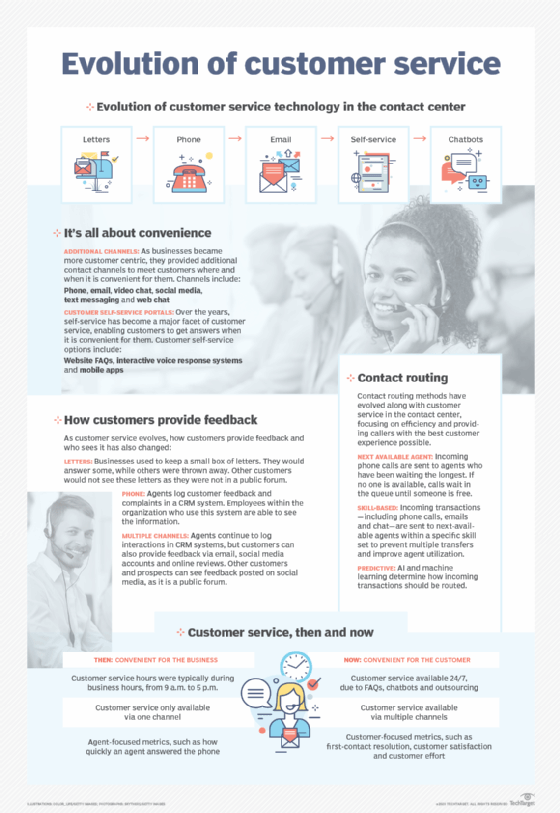What is high-touch customer service?
High-touch customer service is a category of contact center interaction that requires human interaction. It can be contrasted with low-touch customer service, which uses automated phone systems and online self-service portals to answer customer questions, address customer needs and process business transactions. Some contact centers train specific agents to deal with high-value customers and complex problems.
What is high-touch vs. low-touch customer service?
In customer service, touch refers to the amount of human interaction and personal contact involved in supporting the customer base. High-touch customer support involves a lot of human contact with customers. It is more hands-on, personalized, focused on customer interactions and a key part of customer satisfaction and customer loyalty.
Low-touch service involves little, if any, human contact. Unlike a high-touch customer service strategy, the low-touch approach relies more on tools, automation and prebuilt content to help customers, answer queries and resolve issues.
Consider the triage system for consumers in software technical support. Low-touch communications, such as an online community, a frequently asked questions (FAQ) section or a customer self-service portal can support simple requests. Complex issues may require the human-touch, white-glove approach of a customer service team whose agents are well-trained in resolving such problems.

High-touch service examples
A good example of high-touch customer service is a business-to-business (B2B) or business-to-consumer (B2C) company onboarding a new customer with personalized onboarding. In that process, customers can learn, through one-on-one engagement, how to use a product or service effectively.
There are many high-touch ways to onboard customers, including the following:
- Email and social media.
- Personalized attention with real-time customer interactions.
- Face-to-face meetings or calls with a dedicated customer success manager.
- Product demos or training (on-site or remote).
- Special access to product content, such as demos, FAQs, videos and forums.
- One-on-one chat or phone-based support.
- Personal strategy sessions using customer data.
- Dynamic and proactive follow-up to obtain customer feedback.
Providing high-touch service, some companies also schedule regular check-ins with customers. These are especially common for high-value or repeat customers, and are designed to increase customer retention and reduce churn.
By regularly checking in with customers, organizations can deepen their customer relationships by providing world-class account management, which can drive repeat sales and higher revenues.
Check-ins are also a good way for customer support teams to find gaps that may exist between customer expectations and company performance. On discovering these gaps, companies can implement appropriate measures to streamline workflows and processes and align their goals with the customer's goals. Check-ins can also reveal opportunities for upsells and cross-sells.
Low-touch service examples
Self-service counters or kiosks, automated teller machines, vending machines and AI-enabled chatbots are common examples of low-touch service. Many companies taking this approach also provide video tutorials and access to knowledge bases that help customers find answers to common questions without involving a human service agent. Many customers prefer this approach.
Here are some other examples of low-touch service:
- Reservations or appointments via a website or app.
- Interactions using social media.
- Automated product or service emails.
- Automated notifications (e.g., for product upgrades).
- Interactive voice response systems.
High-touch vs. low-touch
The key feature that distinguishes a high-touch engagement model is its emphasis on personalized interactions and customer-centric service. Businesses that adopt this model are poised to engage with customers in a one-on-one manner to give them the high-quality service they expect.
These companies also view customers as valued entities with unique characteristics and requirements. They focus on building strong customer relationships and make an extra effort to provide tailored solutions aligned with the needs of particular customers. They offer one-on-one support, often on the customer's preferred channel (whether phone, email, video or something else).
A low-touch customer engagement model is one in which the company rarely interacts directly with customers. This doesn't mean that it doesn't support them. It does that with fewer humans and more automated support processes, digital engagement tools and self-service resources like FAQs and video tutorials. Organizations whose low-touch approach can be shifted quickly into a high-touch experience (e.g., prospect clicks on a phone access link to speak with a representative) may benefit from that capability if it's not cost-prohibitive.
This table highlights the key differences between high-touch and low-touch engagement models.
| High-touch engagement | Low-touch engagement | |
| Type of customer engagement | Mainly human-to-human | Low level of human engagement; more engagement via tools and self-service resources |
| Personalization | Very high | Low |
| Scalability | Difficult to scale | Easy to scale |
| Priority | Customer happiness and enhanced experiences | Resolution speed |
| Cost | High-cost | More cost-effective |
Benefits, challenges of high-touch customer service
Since high-touch customer service involves offering personalized, customized support, it typically makes customers feel more valued. When customers feel more valued, they tend to be more loyal and tend to keep buying products or services. This boosts revenue, reduces churn and increases retention.
Though broadly beneficial, the high-touch model is costly and difficult to implement. Before implementing the model, organizations must first understand their customers and identify their needs. Appropriate resources must be implemented, including contact center agents, customer service managers and onboarding systems. All of this can increase costs.
High-touch customer service is best implemented for high-value customers or in industries where offering personalized support has a high potential return on investment. In some situations, chatbots, self-support kiosks and other low-touch service methods are sufficient to support customers, so there's no need to make more substantial investments.
Best practices to deliver high-touch customer service
Companies willing to provide high-touch customer service can do so with these best practices:
- Invest in a customer relationship management (CRM) tool that provides a comprehensive view of customers and allows for customer segmentation.
- Identify high-value customers and hire customer service managers to engage with them.
- Create a customer onboarding process to increase customers' comfort with the company's products or services.
- Regularly touch base with customers to gather feedback and understand their current challenges and needs.
- Provide customer-centric training to service agents and other customer-facing staff.
- Send personalized content, resources and emails to important, high-value or repeat customers.
- Identify areas of friction in service processes and implement controls to minimize it.
- Regularly review and act on complaints.
Tips for implementing a high-touch customer experience
While the costs associated with a high-touch customer experience (CX) can be significant compared to a low-touch model, organizations wishing to introduce or migrate to a high-touch model can take these steps in that direction:
- Examine the current business environment and determine how a high-touch model will improve sales and customer retention.
- Review with leadership how a greater understanding of customer needs and expectations can strengthen performance in key revenue-generating areas.
- Consider working with a third party with experience in high-touch customer service planning and implementation; it may help identify a more cost-effective approach than simply "rolling the dice."
- Examine how CRM systems may be able to automate and enhance current low-touch functions and possibly support migration to a full high-touch environment; this could occur with third-party assistance.
- Consider speaking with managers of operational high-touch systems for insights on what works best and how to reduce the likelihood of problems.
- Speak with representatives of key customers to get their thoughts on what is important to them in a high-touch environment.
- Join professional organizations such as the National Customer Service Association to meet and learn from other customer service leaders.
- Implement a new CX environment in phases so that customer agents and contact center managers can gradually gain experience and the system can be fine-tuned to customer needs at a sustainable pace.
- Once the new CX environment is operational, methodically phase out the previous technologies unless they can be integrated into the new platform.
- Consider cloud-based high-touch solutions as they can be scaled quickly if needs change and can reduce the need for office and data center space because agents can work from home.
- Use artificial intelligence (AI) capabilities that are being built into today's CRM platforms and can greatly enhance the overall experience by providing better data analytics and better matching of customer needs with relevant products and services.
The future of high-touch customer service
Both high-touch and low-touch customer service models have important roles in business today and into the future. As people interact with businesses, their willingness to use high-touch interactions is based on how those interactions are designed and implemented.
The use of AI is expected to be an increasingly integral part of customer management, according to Gartner, which predicted that by 2025, approximately 80% of customer service and support organizations will be using some form of AI technology to improve agent effectiveness and CX.
Compare top CRM systems and customer success software platforms. Explore steps to create a voice of the customer program and read about what a customer service manager does. Check out the differences between customer service vs. customer experience.






